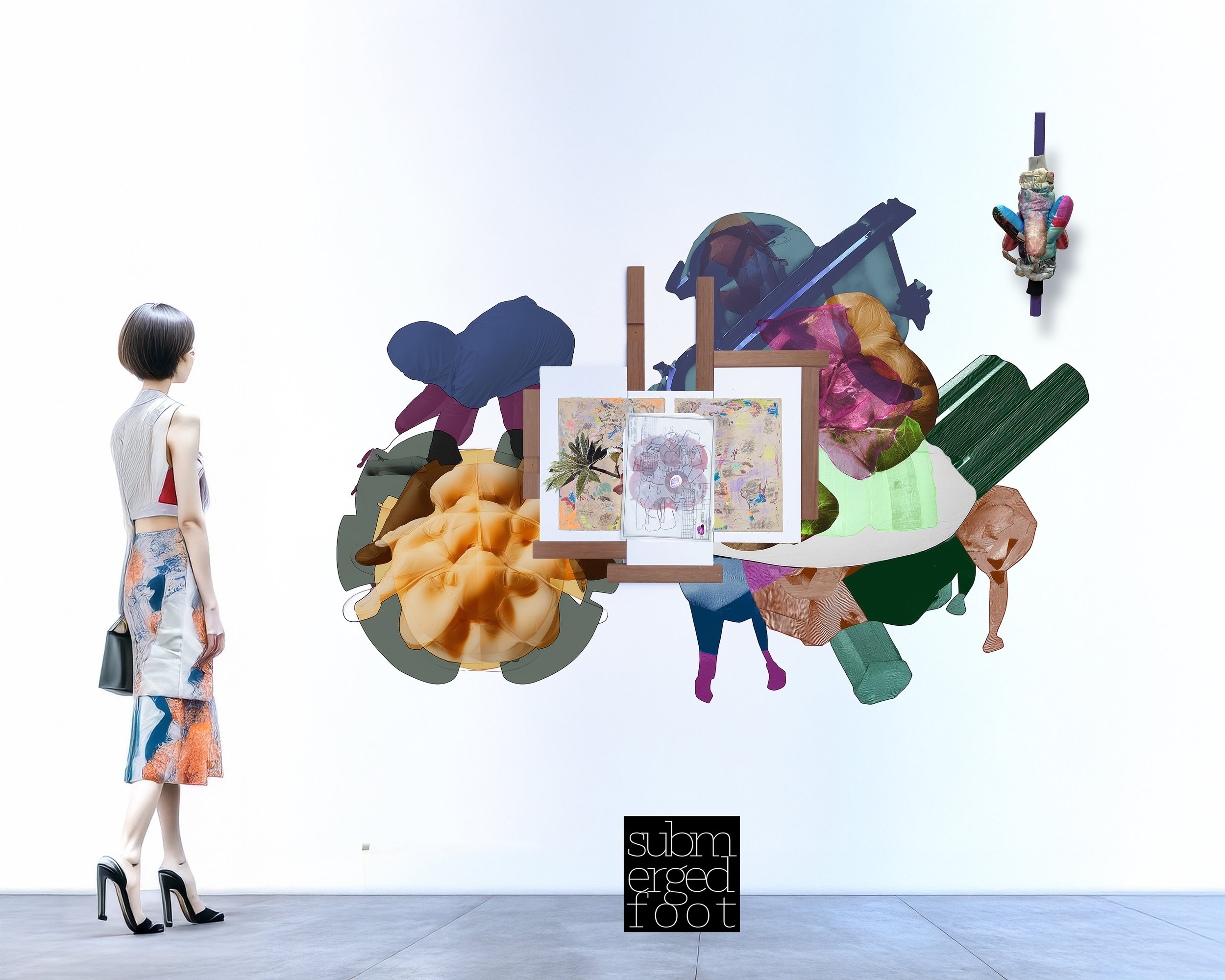Individual Work Plans: Physical Works with Artist-and-AI Offspring Imagery & Nocturnal Snapshots
Each study pairs a single mixed-media piece with either image-to-image AI–blended montages (generated exclusively from the artist’s own source material and then further refined by hand) or enlarged iPhone night-scape photographs—or a combination of the two.
These digital elements, realised as mural wallpaper, wall vinyl, or shaped aluminium panels, will be scaled and colour-balanced on site to achieve the most sensitive, site-responsive installation.
*A fuller curatorial overview is provided in the exhibition proposal at the end of this page—please refer to that section for additional context.
Oil and coloured silver/aluminium leaf on debarked kōzo sticks—discarded paper-mulberry cores from traditional washi-making—attached to nine archival paper mounts taken from an early-twentieth-century pictorial folio. Fleeting coloured-pencil marks echo the ageing stains of the paper, conjuring an indeterminate, wall-hung entity that hovers between object, surface, and trace. Stripped of explicit imagery yet carrying a subdued historical weight, the work fuses craft remnants, time-worn material, and ghosted narratives into a single, quietly resonant presence.
Proposed Installation Schemes: Groupings, Wall Treatments & Spatial Interventions
This sketch offers one possible layout idea for arranging the satin sculptures, tailored structures, and multi-screen display in a white-cube gallery space.
Half-Here Night-Gleam
Exhibition Proposal — GDM Taipei
(Prepared for Kelvin Yang & Lisa Dai)
1 Conceptual Terrain
Inagawa’s practice operates within a porous ontology: boundaries between painting, photographic trace, sculptural form, and algorithmic image dissolve into mutual influence. This fluid condition echoes his self-description as an “in-between entity—half-alien and half-native,” shaped by formative years in Tokyo, London, and now Onomichi. He is fully aware that invoking quasi-spirituality can seem a bold—sometimes even faintly nonsensical—thought-experiment, yet he courts that ambiguity deliberately, treating it as one atmospheric layer that lends quiet resonance to the entire body of work. The result materialises a state of ongoing internal exile, questioning how elusive affect migrates across media, context, and cultural geography.
2 Material Methodologies
2.1 Wall-Based Mixed-Media Assemblages
Re-worked surfaces—ranging from once-finished canvases to salvaged chip-board panels cut from discarded furniture—function as restart points rather than endpoints. Onto (and sometimes into) these supports, Inagawa grafts fresh layers: trimmed timber, debarked kōzo sticks, metal leaf, photo shards, coloured-pencil smears, and slivers of text. The base—whether fabric, plywood, or composite board—acts like a root stock, while each inserted fragment becomes a scion, fusing into a hybrid anatomy that hovers between drawing, collage, and painting. Refusing to settle in any single category, these wall works embody the porous, perpetually revised logic that runs through the entire exhibition.
View images of the physical works used in the mixed-media series
Learn more about the materials behind the physical works
2.2 AI-Assisted Digital Montages & Nocturnal Photographs
Fragments from earlier abstract digital works are recombined in Midjourney, spawning new “offspring” images. The enquiry: Can a fragile quasi-spiritual charge survive algorithmic alchemy—be preserved, mutated, or extinguished?
Displayed nearby, large-format iPhone night photographs of Onomichi’s football pitches, highways, and riverbanks stand as independent visual counterpoints (never used as AI input). Floodlights and car headlamps combine with smartphone auto-correction to yield quietly numinous scenes—the “real-world ether” set against the “digital ether” of the AI montages. Both registers cross-pollinate with the materially dense wall pieces, producing a tri-layered field where material presence, photographic liminality, and algorithmic speculation coexist.
2.3 Satin Sculptural Punctuations
Soft forms first developed for easY mechanisM, Speak Spindle, and Fluxosphere return as sculptural “commas.” A matched pair of wearable satin pieces is threaded through its arm-holes by colour-washed wooden rods bevelled to crisp edges—speared kebab-style, if suspended from the ceiling, they read like artificial stalactites, their tips drawing the gaze downward. Yet the same elements can also stand upright on the floor as totemic markers, or be mounted against the wall, where a hand-drawn mural or digital wall print can serve as a shifting backdrop. Whether hanging, standing, or floating in front of a graphic field, these satin bodies punctuate the gallery rhythmically, mediating tactile presence and digital surface.
2.4 Optional Time-Based Work — Meet the Sealion
Shot in 2022 at VILLA WASAKU (a renovated Taishō-era house in Onomichi), this 13-minute video combines studio objects, historical artefacts, and two mute “gatekeepers”. Twenty-three AI-voiced text fragments—drawn from Twitter debates on feminism and discrimination—overlay dream-like scenes, reflecting the quiet dislocation of life in Onomichi.
Possibly shown on a monitor or projected, the piece can stand alone or expand into a multi-screen constellation using Inagawa’s wider archive of digital footage—wall-mounted or projected, floor-based, or integrated into tailored structures—further deepening the dialogue between the material and digital realms.
Learn more about Meet the Sealion
3 Curatorial Logic
The installation foregrounds productive friction: flat image versus volumetric object, manual gesture versus algorithmic accident, sacred tone versus sly parody. Works function as interdependent nodes, their resonances accumulating rather than resolving, mirroring the artist’s navigation of belonging and estrangement.
4 Spatial Sensitivity
Modular hanging of wall works, shown either in clusters or as single statements.
Variable scale for digital prints, adaptable from modest to mural size.
Freestanding or suspended satin sculptures, with tailor-made structures or settings for video monitors and projections.
Temporary, movable partitions—or other custom-built assemblages—can be introduced, freeing the display from the gallery’s fixed walls and actively re-mapping sight-lines and visitor flow.
Flexible placement of video and audio elements to secure optimal sight-lines and acoustics throughout the space.
This adaptability underscores Inagawa’s ethos of permeability, contingency, and open-endedness—perfectly aligned with GDM Taipei’s experimental brief.
5 Outcome
Visitors progress through material, photographic, and algorithmic registers, encountering a layered meditation on how images accrue affect, how objects host memory, and how a diasporic artist translates personal terrain into shared experience.
















